I. Sector Landscape and Outlook
Australians have been embracing technology to enrich lives. Commonwealth of Australia has an affection towards technology - an array of policy support to make a floor for technological innovation, advancement and development reflects the same, which will indeed drive the economic prosperity. In 2018, Commonwealth Scientific and Industrial Research Organisation’s (CSIRO) Data61 estimated that digital innovation could add $315 billion to the gross economic value of the Australian economy over the next decade. The burgeoning sector is directly/indirectly having its reach across various industries and other sectors and has been playing a vital part in improving the productivity of various organisations, let’s have a closer look.
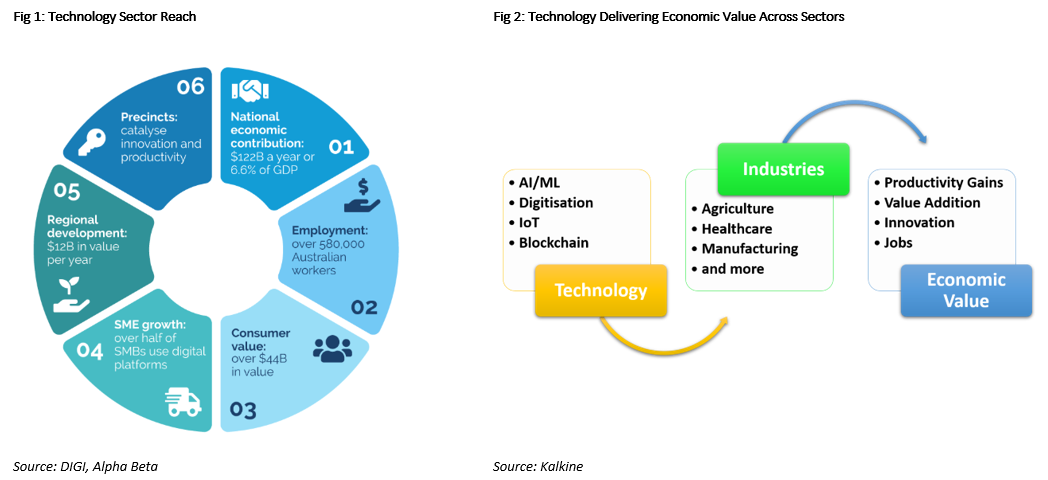
Agriculture: Modern-day farmers are accustomed to delivering superior outcomes by leveraging technology, and GPS-guided/self-steering tractors are a normal part of the agricultural ecosystem across the developed nations and Australia in particular. Future lies in yield-tech, drones, data penetration in crop management.
FinTech: Technology is also augmenting the financial services industry. As per FinTech Australia, there are over 800 fintech businesses operating in the country, and the space is pegged to be a $4 billion industry by 2020 from $250 million in 2015. FinTech in Australia is driven by high mobile phone penetration, high contactless payment penetration, investment management businesses, blockchain capabilities, regulatory framework etc. One popular player to be talked about is Afterpay (ASX: APT) that provides technology-driven payments solutions for consumers and businesses.
Manufacturing: Australia has been leveraging technologies to modernise processes. Australian manufacturing industries use robotics, internet-of-things, artificial intelligence, 3D printing, modelling technologies in daily business operations.
Mining: Mining is one of the major industries in the country, and technology has been driving productivity and safety in the sector. Driverless trains and trucks are common in the Australian resources sector. Emerging technologies like 3D printing, drones, sensors are likely to deliver superior outcomes for the mining sector over the course of the decade. Codan Limited (ASX: CDA) is a name in this area and it has been providing metal detecting solutions.
Tourism: The country is perhaps one of the top destinations due to its wildlife parks, beaches, and even coastal reefs. Digital technology is playing an important role in mobilising a swift travel experience for customers, including online booking platforms. Additional pocket share through data exploitation is likely to deliver better cash flows for the businesses.
Education:The digitisation of the education sector is gathering momentum, and the present situation may need schools to unlock the capability of operating online as a disaster management response. This adoption of technologies in the educational sector is not only changing ‘what to teach’ but ‘how to teach’ as well. At the backdrop of social distancing due to COVID-19 pandemic, the use of technology in education has rather accelerated.
Health: Perhaps the most buzzing word in the world right now, the healthcare sector has been facing unexpected volumes of patients at the backdrop of COVID-19. Technological advancements in the healthcare sector are revamping the way doctors interact with patients. Hospitals have been embracing digitisation to better address patient flow and management. Robotics is being applied to deliver superior surgery outcomes, while consumers are accessing health care services online and DIY devices with an increasing number of new sensors.
With the broad understanding of the impact of technology on various sectors, time to dig deeper into the developments within this sector.
Emerging themes in the technology sector: Artificial Intelligence and Machine Learning are already expanding its reach and presence in the world. It is used in a number of processes these days, including voice recognition and commands, decision support management, customised digital marketing etc. AI & ML have additional scalability in our daily lives as well as in businesses through the automation of processes and new decision-making capabilities.
Blockchain is a platform that verifies and stores transactions across a shared network of computers; thus, it eradicates the requirement of traditional banking systems. Many financial institutions across the globe have embraced blockchain in settlement and clearing systems. It could be used in the government benefits delivery through validating an individual’s identity and reducing the level of corruption.
Internet of Things (IoT) is a popular technology, which refers to the increasing number of sensors that are used to record sounds, movement, temperature, touch etc. Sensors are used to automatically collect the data according to their needs. IoT has scalability in energy and water infrastructure, soil sensors, healthcare etc.
Further, Quantum Computing would improve the computing power available to consumers exponentially, while also enabling the consumers to solve problems that are not easy to solve through existing systems. And Australia is recognised as a leader in the silicon-based quantum computing research.
Australia’s Digital Opportunity: As Data61’s report suggested that $315 billion could be added in gross economic value to Australia. It seeks to develop new digital opportunities in areas where the country is globally competitive. Digital innovation is enhancing the ways how businesses operate in Australia, and it adds economic value by improving productivity, adding new revenue streams, products and services.
It identified eight areas where Australia could improve economic value. Precision Healthcare woulduse connected healthcare data across systems to allow next-level healthcare service delivery. Digital Agriculture included leveraging sensors, robotics, machine learning to improve agricultural capabilities and outputs.
Data-Driven Urban Management would see additional harnessing of data to better design and operate infrastructure and cities, including sensor data, geospatial data, people movement and construction. Cyber-Physical Security to ensure the protection of key physical assets and infrastructure.
Fig 3: 4th Industrial Revolution in the Making
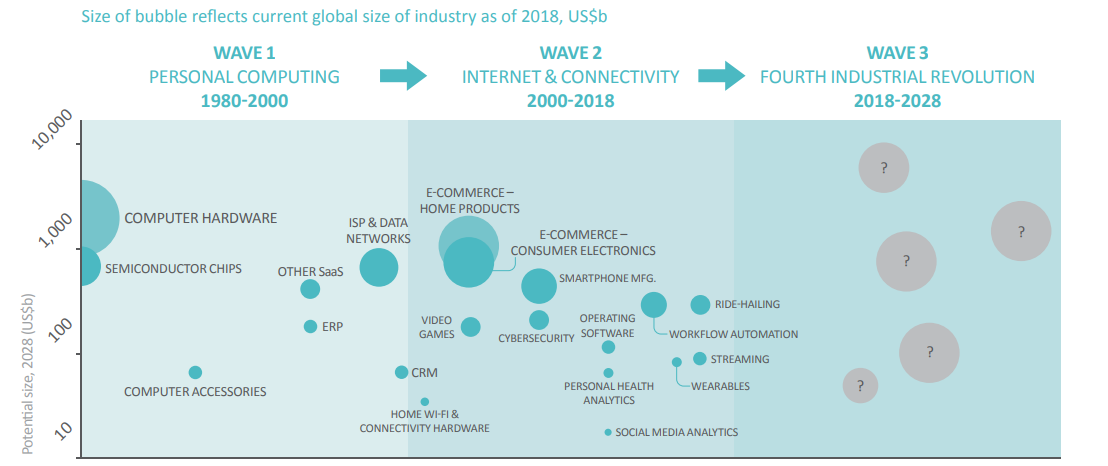
Source: CSIRO Data61
Supply Chain Integrity intends to have connected sensors and distributed ledger to build trust in the transactions and product mobilisation. Proactive Government to leverage additional data sets to improve policy deployment and decision making. Legal Informatics wouldapply AI & ML to automate process flows, compliance and administrative deliveries. Smart Exploration & Production to harness machine learning techniques for a greater automaton that would see the efficiency of resource discovery and production. Lets now shift our focus towards the policy initiatives taken by the government to boost this sector.
Policy initiatives to drive technological advancements: The Australian Government not only embraces the technology advancements but empowers it as well. It has collaborated with Germany for information sharing, increase in trade and investment, strategic dialogue, cooperation in education and science.
Fig 4: Government Backs Technological Advancement
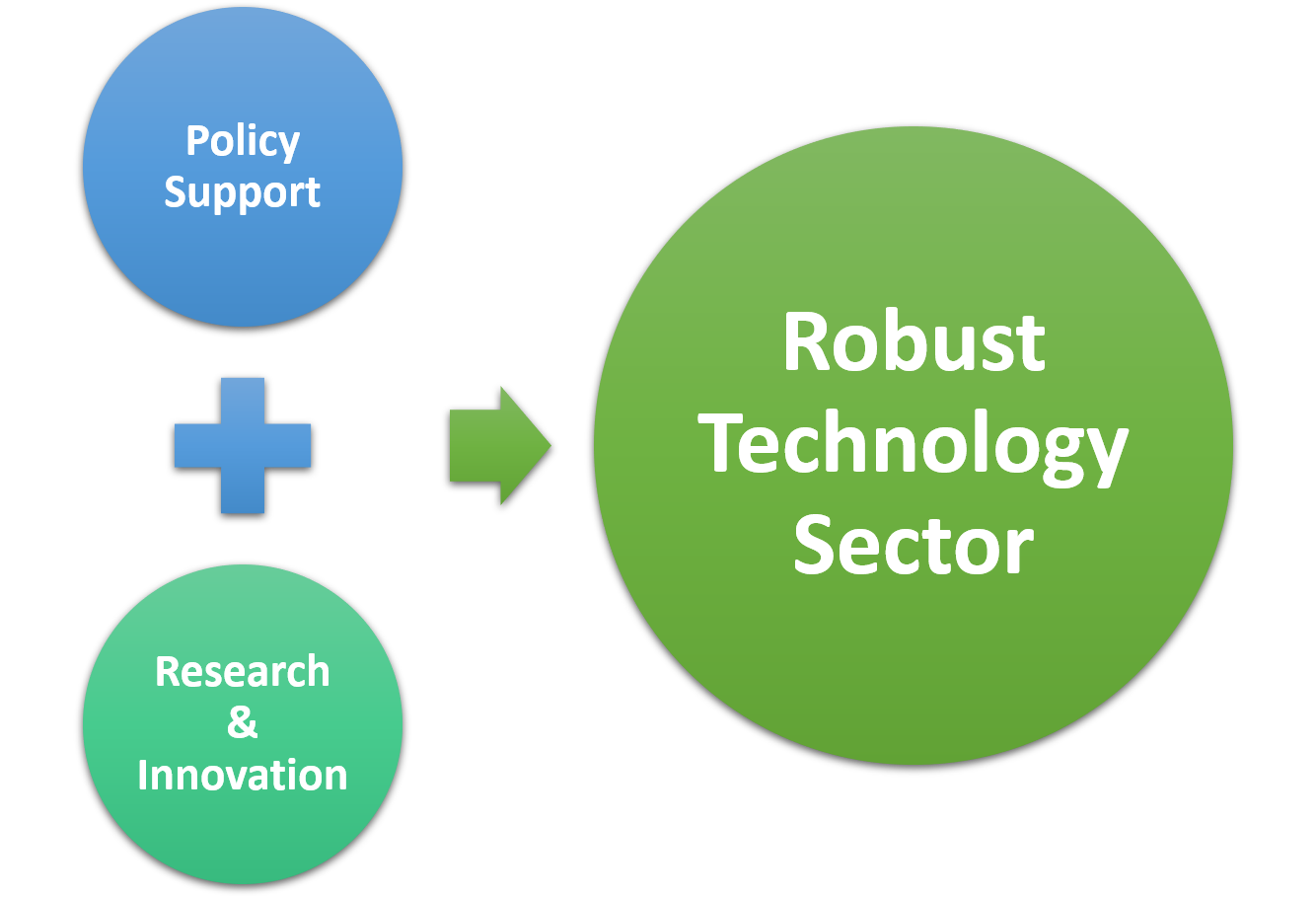
Source: Kalkine
Commonwealth of Australia also runs test labs program that seeks to prepare businesses to transition into smart factories for the future. Meanwhile, the Government has prioritised manufacturing, cybersecurity, food and agribusinesses, medical tech and pharma, mining equipment tech and service, oil gas and energy resources.
Government has also committed to invest $2.4 billion in world-class satellite imagery, supercomputers, GPS, meteorology, space agency and research in artificial intelligence. Also, the Government runs R&D tax incentive scheme and eligible firms with a turnover of less than $20 million receive a tax offset, which is refundable, and other eligible businesses receive a non-refundable tax offset.
Also, the Government is collaborating with India on science and research through the Australia-India Strategic Research Fund (AISRF). The priority sectors include agriculture, astronomy and astrophysics, clean energy technologies, information and communication technology, nanotechnology and more.
The technology sector in Australia has garnered quite a bit of attention on the global front too, as a testimony to the same, a new technology index was launched- The S&P/ASX All Technology.
Launch of the All Technology Index: The S&P/ASX All Technology Index was launched in February this year, and it marks a landmark moment for the country’s technology sector. It reflects the urge to provide an identity to the tech companies in Australia, a source of capital and global visibility. At the time of launch, the index had a market capitalisation of over $100 billion with 46 constituents. It includes a host of businesses that started as a small-cap company and now are worth billions of dollars. Australian Stock Exchange has been emerging as ‘go-to’ location for many small businesses, especially in less than $500 million range.
Fig 5: Performance of Technology Index against ASX 200
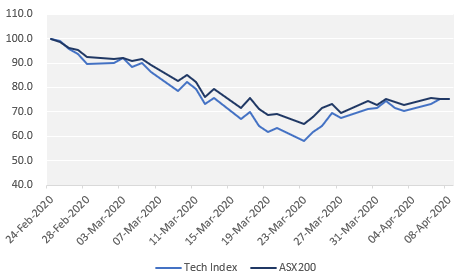
Source: Thomson Reuters
In June 2019, BDO Global noted that companies are increasingly looking to list in Australia, especially technology companies. Also, the Australian investor base has special warmth for the technology-based companies.
Coronavirus Impact: Although the COVID-19 implications have bought the world on its knees, the technology sector players are likely to have idiosyncratic business impacts. However, a global recession could soften the growth in overall technology sector due to lack of demand. At the same time, some technology businesses are thriving due to respective business models as some of the businesses are enabling other businesses to work remotely, Megaport (ASX: MP1) is one company benefiting from this. Given the sector is service driven, most of the businesses have faced minimal impact in operating remotely.
II. Investment Theme and Stocks under Discussion (MP1, CDA, APX, APT, ALU)
Let’s now look at five promising technology companies listed on the ASX, which are well positioned to capitalize on the opportunity that would unfold in the near future. We have evaluated the stocks by ‘Price to Sales’ method.
Fig 6: Relative price performance of the stocks under discussion against ASX 200 and Information Technology Index (1 Year)
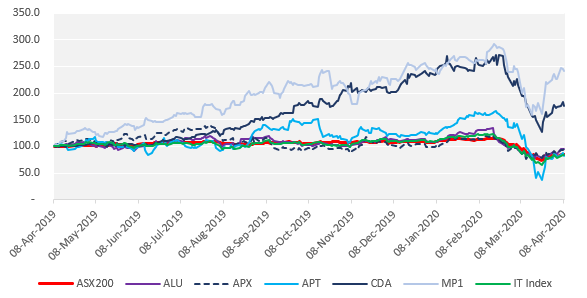
Source: Thomson Reuters
1. ASX: MP1 (MEGAPORT LIMITED)
(Recommendation: Buy, Potential Upside: Low Double Digit)
Megaport Limited is a provider of elastic interconnection services which help the customers in interconnectivity and flexibility between other networks.

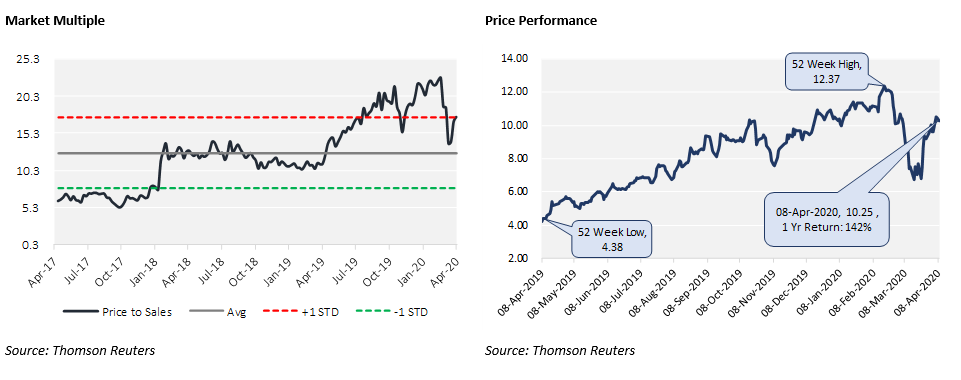
Valuation
Amid the current situation where people are locked in the home, the group is witnessing high demand in connections supporting Virtual Desktop Infrastructure, cloud-based productivity applications, ERP and public cloud-enabled business applications. We believe the current uncertainty to drive the demand for cloud services and connectivity solutions to unprecedented levels which is beneficial for Megaport. The group has generated a solid one-year return of 142%. The stock has corrected only ~3% YTD amid free fall in the global markets and significantly outperformed the benchmark by ~22% and ~32% in last one month and three months, respectively. The stock is currently trading at forward P/Sales multiple of ~18.5x, and we believe the multiple to further expand on account of the abovementioned reason. Our illustrative valuation model suggests that the stock has a potential upside of ~17% on 8 April 2020 closing price.
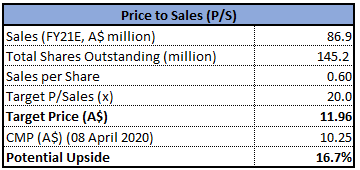
2. ASX: CDA (CODAN LIMITED)
(Recommendation: Buy, Potential Upside: Low Double Digit)
Codan Ltd is a technology hardware and equipment company with the operational interest lies in design, development, manufacture and marketing of communications equipment, metal detection and tracking solution.

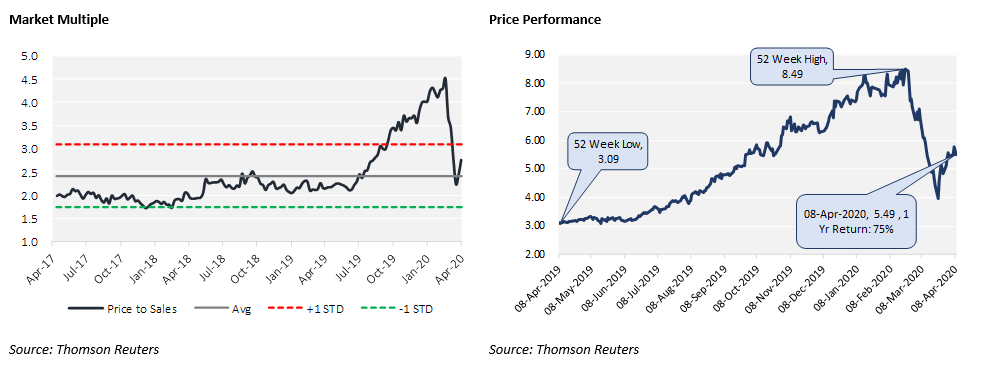
Valuation
The solid financial performance of the company in the 1HFY20 along with hefty interim dividend announcement in time where yields are plummeting across the globe made the stock attractive. The stock has outperformed the benchmark significantly by 118% on an annual basis. The company recently announced that COVID-19 situation is not going to affect its supply and the group is on track to continue with the momentum gained in the first half of the year.The stock is currently trading at forward P/Sales multiple of ~2.9x, and we believe the multiple to further expand on account of the abovementioned reason. Our illustrative valuation model suggests that the stock has a potential upside of ~14% on 8 April 2020 closing price.
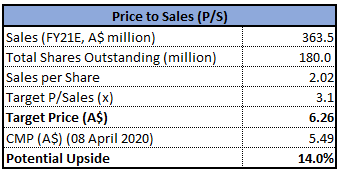
3. ASX: APX (APPEN LIMITED)
(Recommendation: Buy, Potential Upside: Low Double Digit)
Appen Limited is a global leader in the development of high-quality, human-annotated datasets for machine learning and artificial intelligence.

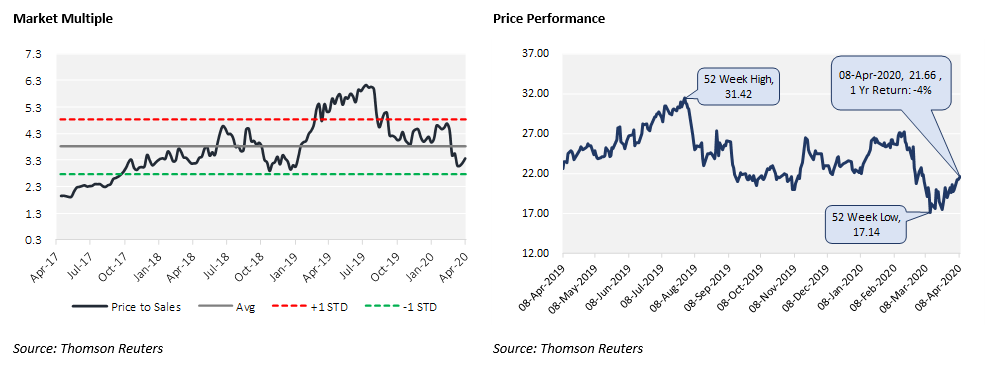
Valuation
APX is experiencing larger customer wins and is moving on the path of profitability. It is maintaining strong and enduring customer relationships with rapid expansion in the pipeline. Despite the outbreak of coronavirus, the targets of 2020 of the company are modest. Appen is ideally placed to fulfil the high demand for large volumes and continued to develop and invest in technology, which will allow the company to increase the quality of deliverables and deploy new capabilities. The stock has significantly outperformed the benchmark index in last one month (~23%) and three months (~30%). The stock is currently trading at forward P/Sales multiple of ~3.7x, and we believe the multiple to further expand on account of the abovementioned reason. Our illustrative valuation model suggests that the stock has a potential upside of ~12% on 8 April 2020 closing price.
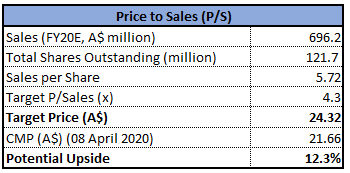
4. ASX: APT (AFTERPAY LIMITED)
(Recommendation: Buy, Potential Upside: Low Double Digit)
Afterpay Limited provides technology-driven payments solutions for consumers and businesses through its Afterpay and Pay Now services and businesses.

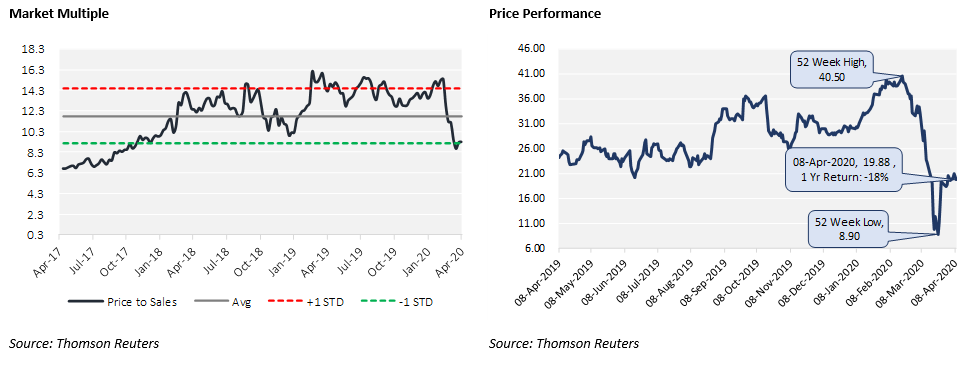
Valuation
Outbreak of COVID-19 is generating challenging conditions and creating considerable concerns in financial markets. Despite these challenges, the company has not seen a material impact on its business activity. The strong business model, balance sheet and customer base are creating a level of protection in times of economic uncertainty. The resilient financial position provides APT with the ability to both continue to fund its operating expenditure and significantly expand its business activities in the medium term. The stock is currently trading at forward P/Sales multiple of ~8x, and we believe the multiple to further expand on account of the abovementioned reason. Our illustrative valuation model suggests that the stock has a potential upside of ~17% on 8 April 2020 closing price.
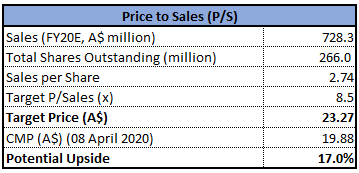
5. ASX: ALU (ALTIUM LIMITED)
(Recommendation: Buy, Potential Upside: Low Double Digit)
Altium Limited is engaged in the development and sales of computer software for the design of electronic products.

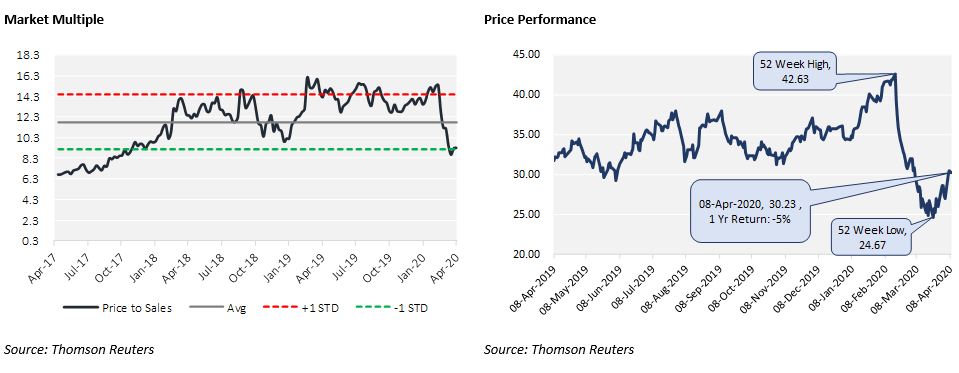
Valuation
There is no doubt that Altium has growing momentum toward market dominance. It has set its long-term targets which are strategic in nature. Despite the vagueness encircling COVID-19, the company is operationally and commercially well-positioned and is well geared to work digitally with an increased focus on driving productivity. The company has a decent operating model and is highly adaptable to the new global conditions. Altium is continuing to close sales and has a robust pipeline of opportunities. ALU is financially very strong with profitability and a strong balance sheet. The stock has outperformed the benchmark index ~22% and ~15% on one month and three months basis, respectively. The stock is currently trading at forward P/Sales multiple of ~10.8x, and we believe the multiple to further expand on account of the abovementioned reason. Our illustrative valuation model suggests that the stock has a potential upside of ~16% on 8 April 2020 closing price.
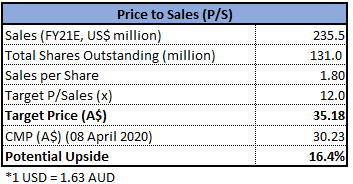
Note: All the recommendations and the calculations are based on the closing price of 8 April 2020. The financial information has been retrieved from the respective company’s website and Thomson Reuters
Disclaimer
The advice given by Kalkine Pty Ltd and provided on this website is general information only and it does not take into account your investment objectives, financial situation or needs. You should therefore consider whether the advice is appropriate to your investment objectives, financial situation and needs before acting upon it. You should seek advice from a financial adviser, stockbroker or other professional (including taxation and legal advice) as necessary before acting on any advice. Not all investments are appropriate for all people. Kalkine.com.au and associated pages are published by Kalkine Pty Ltd ABN 34 154 808 312 (Australian Financial Services License Number 425376). The information on this website has been prepared from a wide variety of sources, which Kalkine Pty Ltd, to the best of its knowledge and belief, considers accurate. You should make your own enquiries about any investments and we strongly suggest you seek advice before acting upon any recommendation. Kalkine Pty Ltd has made every effort to ensure the reliability of information contained in its newsletters and websites. All information represents our views at the date of publication and may change without notice. To the extent permitted by law, Kalkine Pty Ltd excludes all liability for any loss or damage arising from the use of this website and any information published (including any indirect or consequential loss, any data loss or data corruption). If the law prohibits this exclusion, Kalkine Pty Ltd hereby limits its liability, to the extent permitted by law to the resupply of services. There may be a product disclosure statement or other offer document for the securities and financial products we write about in Kalkine Reports. You should obtain a copy of the product disclosure statement or offer document before making any decision about whether to acquire the security or product. The link to our Terms & Conditions has been provided please go through them and also have a read of the Financial Services Guide. On the date of publishing this report (mentioned on the website), employees and/or associates of Kalkine Pty Ltd do not hold positions in any of the stocks covered on the website. These stocks can change any time and readers of the reports should not consider these stocks as personalised advice.
AU





















 Please wait processing your request...
Please wait processing your request...